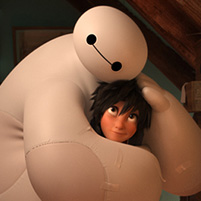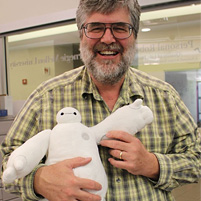Inspired Robotics


Chris Atkeson
When Director Don Hall saw a robot arm made of balloons at Carnegie Mellon University's Robotics Institute several years ago, he knew instantly that Baymax, a pivotal character in a Disney animated feature, also would be an inflatable robot.
In the action-packed, comedy-adventure "Big Hero 6," a robot designed to care for humans is transformed into a fighter that joins a band of high-tech heroes. Among the cast of voices is CMU alumnus James Cromwell (A'64).
Baymax, while fictional, reflects a growing field of research at CMU called soft robotics. CMU has hired two new professors who work in this area: Carmel Majidi and Yong-Lae Park.
"The movie is a tremendous win for soft robotics," said Chris Atkeson, professor of robotics. Mobile robots made from soft materials — fabrics, balloons, light plastics — offer advantages over metal robots, including lower weight, lower cost and greater safety when operating near people, he noted.
In the public mind, robots are almost universally metal — whether they be the industrial robots assembling cars or the robots of popular science fiction, such as WALL-E. In the future, some robots will be wearable, others disposable.
"I think this movie will be inspirational for a lot of people," Atkeson added.
At CMU, researchers are proving that these soft robots can do real work while developing technologies, such as artificial muscles, touch sensors and pressure-sensitive skins, that will make them practical.
Park, assistant professor of robotics, is working with Atkeson to develop a lightweight robotic arm that will use balloon-like artificial muscles and use balloons as exterior cushions.
Park also is developing new types of soft sensors and soft actuators for controlling robotic devices, as well as devices that could be used to compensate for limb disorders or to extend human capabilities.
The inflatable robotic arm that proved so inspirational to Hall was developed in Atkeson's lab by Siddharth Sanan, then a graduate student.
"We did not invent the idea of an inflatable robot arm," Atkeson said, "What we wanted to know was — how do we make it practical?"
A project within CMU's Quality of Life Technology (QoLT) Center, the team was particularly curious to learn whether an arm of balloons could do work that required a high degree of safety — giving a patient a sponge bath, for instance, or feeding a patient.
The QoLT Center is focused on research in assistive robotics and other human-computer systems that can support people in everyday living. Examples include personal robots that serve people at home such as HERB, the Home Exploring Robot Butler; computerized coaches for rehabilitation and support in daily functional tasks; and a range of technologies that either extend or enhance the care of professional and informal caregivers.
Health care is a natural application for inflatable robots; robots made of soft materials are less likely to cause injury. But Sanan also emphasizes that inflatable robots could be exceptionally portable — something that could be stowed in a backpack, for instance, or launched into space as a small package.
"We also are looking at cheap ways of making robots," Atkeson said. "One way is to steal from the clothing and toy industries, which already know how to make stuff inexpensively."
He said that fabrics and plastics are inexpensive and cutting them and joining them by melting, gluing and sewing is something accessible to lots of people.
"We're going to make Home Ec hot again," he added.
Related Links: Read press release | Robotics Institute | Soft Machines Lab | Soft Robotics and Bionics Lab | Quality of Life Technology Center
